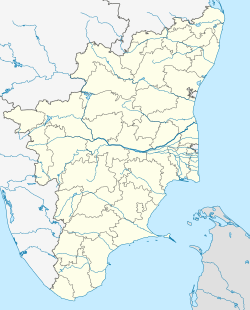Top Qs
Timeline
Chat
Perspective
Komarapalayam
Town in Tamil Nadu, India From Wikipedia, the free encyclopedia
Remove ads
Komarapalayam is a municipality and textile town situated on the bank of the Kaveri, Bhavani River of South India, and is a taluk of Namakkal District, Tamil Nadu, India. Komarapalayam is also called Kumarapalayam.[1] Komarapalayam and Bhavani are twin cities separated by the Cauvery river. However, Bhavani belongs to Erode district. Komarapalayam is famous for its textile industries. As of 2011, the town had a population of 71,594
Remove ads
Municipal administration
In 1978, Kumarapalayam town was upgraded from the status of town Panchayat to Municipality and is now a taluk. It has a population of 71,594 and an extent of 7.10 km2., as per Survey and Land records. The town is divided into 33 wards.[2]
The Municipal Council, composed of 33 ward councillors, is headed by a chairperson who is elected by voters of the town. The councillors elect a Vice-Chairperson from among themselves. The executive wing is headed by a commissioner, and he is assisted by a team of officials including a revenue inspector, sanitary officer, manager, municipal engineer, town planning inspector and other officers.[2]
The annual anticipated income of the town is ₹24 million, and the expenditure is ₹34 million annually.[2]
Remove ads
Demographics
Summarize
Perspective
According to 2011 census, Kumarapalayam had a population of 71,594 with a sex-ratio of 994 females for every 1,000 males, much above the national average of 929.[3] A total of 6,095 were under the age of six, constituting 3,126 males and 2,969 females. Scheduled Castes and Scheduled Tribes accounted for 4.43% and 0.04% of the population respectively. The average literacy of the town was 72.14%, compared to the national average of 72.99%.[3] The town had a total of 20,439 households. There were a total of 37,106 workers, comprising 212 cultivators, 257 main agricultural labourers, 1,767 in house hold industries, 33,774 other workers, 1,096 marginal workers, 19 marginal cultivators, 15 marginal agricultural labourers, 128 marginal workers in household industries and 934 other marginal workers.[4] As per the religious census of 2011, Kumarapalayam had 97.12% Hindus, 1.58% Muslims, 1.22% Christians, 0.0% Sikhs, 0.0% Buddhists, 0.0% Jains, 0.07% following other religions and 0.0% following no religion or did not indicate any religious preference.[5]
Remove ads
Constituency
Traditionally, Kumarapalayam was part of the nearby Tiruchengode Legislative Assembly until 2011. In 2011, it was separated from Tiruchengode to form a new constituency along with Pallipalayam (a nearby town).[6]
See also
References
External links
Wikiwand - on
Seamless Wikipedia browsing. On steroids.
Remove ads
